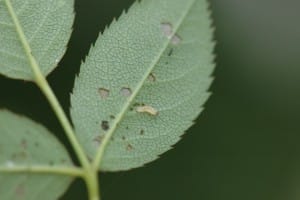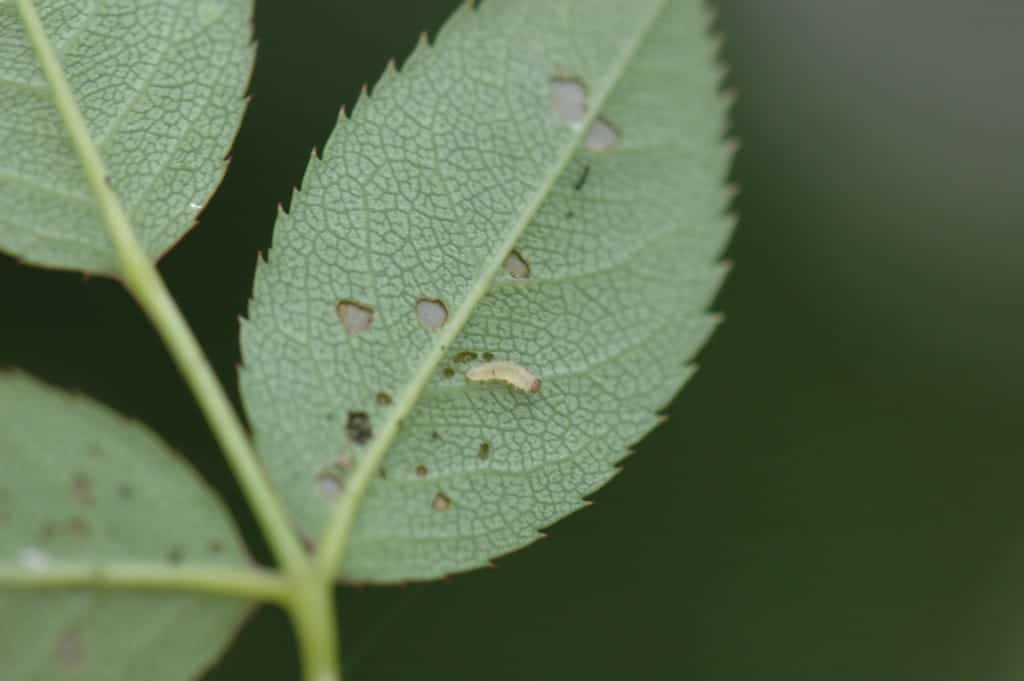
Edited from this article by Paul Pugliese, the agriculture & natural resources agent for the University of Georgia Extension office in Bartow County
A common rose problem this year is injury caused by rose sawflies, also known as rose slugs.
These insects do not discriminate on the types of roses on which they feed. Even ‘Knock Out’ roses make a tasty meal for these critters. Home gardeners often ask why ‘Knock Out’ roses are affected if they are supposed to be problem-free. These roses are bred for resistance to certain diseases, like black spot, but are still damaged by a variety of rose-loving insects.
Sawfly larvae
Sawfly larvae look similar to the caterpillar stages of moths and butterflies, but have six or more pairs of prolegs behind the three pairs of true legs on their body. True caterpillars have fewer prolegs.
Caterpillars can also affect roses in the spring, but the damage they cause is slightly different. Caterpillars chew large holes in the leaves. Sawfly larvae chew a thin layer off the surface of leaves, leaving a skeletonized appearance.
If you hold up an affected leaf, you can see light shining through it. This unique “window pane” damage is a classic sign of sawflies. If you look carefully, you might even find a few, tiny, slug-like larvae on the leaves.
Sawfly damage
Some sawfly species can chew holes through the leaves as they get older, but usually you will see both types of damage on the same plant. Sawfly larvae eventually become small, non-stinging wasps that feed on other insects.
Begin scouting for sawflies in April or early May. Most sawfly species feed through June and will not return again until next spring. The larvae are often found on the undersides of the leaves, so inspect both sides of the leaves carefully. Keep in mind that the damage caused by sawflies is only to the leaves and mainly affects the appearance of the plant. Plants that are otherwise healthy can tolerate significant feeding damage and will usually put out new leaves by mid-summer.
Sawfly control
Sawflies are best controlled when they’re young. You can simply pick them off by hand. A forceful spray of water from a hose can also knock off sawflies. Once dislodged, they cannot climb back onto the plant.
Synthetic insecticides that control sawflies include acephate (Orthene), carbaryl (Sevin), malathion and various pyrethroids. Avoid using insecticidal dusts and spraying flowers, as many insecticides are highly toxic to bees and other pollinators.
Imidacloprid (Bayer Advanced), a systemic insecticide, can be applied to the soil around the roses in spring before feeding activity is noticed. However, once the damage is noticed, it is usually too late for a systemic product to be effective.
Bacillus thuringiensis (Bt) products are effective against leaf-feeding caterpillars, but not on sawflies.
For more answers to gardening questions, contact your local UGA Extension office at 1-800-ASK-UGA1 or search UGA Extension publications at extension.uga.edu/publications.
